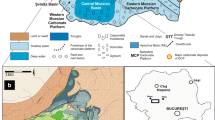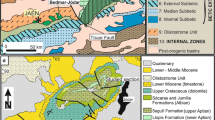Summary
In the Kale (Gümüshane) area in the North Eastern Turkey, platform carbonates of the Berdiga Limestone were deposited during Late Jurassic-Early Cretaceous time in environments varying from intertidal to fore reef. The sequence shows extensive lateral and vertical alterations and interfingering of different facies types. In the upper part of the Berdiga Limestone in the Kircaova area a bituminous thin-bedded to platy limestone and shale 5 to 6 m thick occurs at the Early/Late Aptian boundary. It is underlain by limestones rich in silica nodules of up to 10 cm size.
A facies analysis of a section about 70 m thick including the bituminous interval was carried out in 1994/95 at the SW border of the Kircaova area close to the road from Lörikas to Kale. The limestones consist mainly of packstones and grainstones locally rich in calcareaous algae and forminifera. Fragments of molluscs and echinoids as well as some ostracods and calcispheres occur. Some sponges, corals, and beds rich in molluscs occur in minor amounts in the middle part of the section which is characterized by intertidal to shallow subtidal facies.
Algae and foraminifera indicate a Barremian-Early Aptian age of the lower part and Late Aptian age of the upper part of the section (e.g.Salpingoporellamuehlbergii, Salpingoporella aff.melitae, Clypeina solkani, Novalesia producta), divided by the bituminous limestones.
In West Slovenia (close to the Italian border) a complete Cretaceous section occurs at Sabotin mountain containing Aptian beds with comparable faunal composition. In contrast to the Berdiga Limestone, in Slovenia at the rim of the dinaric platform a patch reef about 50 m in thickness is developed which is also covered by a bituminous limestones (black shale) marking the Early/Late Aptian boundary. Faunal elements in Slovenia arePalorbitolina lenticularis, Cuneolina laurentii, Orbitolina (Mesorbitolina) texana andSalpingopoprella dinarica.
The bituminous limestone appears to be a marker horizon. At both locations it is locally rich in characeans probably indicating a regressive maximum before another transgression began in the Late Aptian/Albian as world-wide drowning event. Possibly the occurrence of the bituminous limestone (black shale) is associated with volcanic activity during the Aptian. If so it could be used as a chronostratigraphic marker horizon in both areas analyzed.
Similar content being viewed by others
References
Akdag, K., Özer, E., Kirmaci, Z., Capkinoglu, S. & Gedik, I. (1994): Gümüshane yöresindeki Üst kretase istifinin Gelisimi (Dogu Pontidler, KO Türkiye).—Abstracts of the Geological Congress of Turkey 1994, Chamber of Geological Engineers of Turkey, p. 85
Altiner, D. (1991): Microfossil biostratigreaphy (mainly foraminifers) of the Jurassic-Lower Cretaceous carbonate succession in north-western Anatolia (Turkey).—Geologica Rom.,27, 167–213, Roma
Arnaud-Vanneau, A. (1980): Micropaléontologie, peléoécologie et sédimentologie d’une platforme carbonatée de la marge passive de la Téthys: l’Urgonien du Vercours septentrional et de la chartreuse (Alpes occidentales).—Géol. Alpine, Mém.11, 874 pp; Grenoble
Arnaud-Vanneau, A. &Chiocchini, M. (1985): Le genreSabaudiaCcharollais & Brönnimann 1965 (Foraminifère Benthique Crétacé) et ses différentes espéces.—Rev. Micropaléont.,28/1, 3–22; Paris
Arnaud-Vanneau, A. (1986): Variations dans la composition et dans la diversité des faunes de foraminifères benthiques du Crétacé inférieur sur quelques platesformes carbonatées téthysiennes de l’Europe et du Moyen Orient.—Bull. Soc. Géol. France, (8),2/2, 245–253, Paris
Arnaud-Vanneau, A., Boisseau, T. &Darsac, C. (1988): Le genreTrochilina Paalzow 1922 et ses principales espèces au Crétacé.—Rev. Paléobiologie, Vol. Spec.2 (Benthos’ 86), 353–377, Genève
Aissaoui, D.M. &Purser, B. (1983): Nature of origins of internal sediments in Jurassic limestones of Burgundy (France) and Fnoud (Algeria).—Sedimentology,30, 273–283, Oxford
Berner, R. A. &Barron, E. J. (1984): Comments on the BLAG Model: Factors affecting atmospheric CO2 and temperature over the past 100 million years.—Amer. J. Sci.,284, 1183–1192
Borza, K. (1984): The Upper Jurassic-Lower Cretaceous parabiostratigraphic scale on the basis of Tintinnidae, Cadosinidae, Stomiosphaeridae and other microfossils from the West Carpathians.—Geologicky Zbormik-Geologica Carpathica,35, 539–550, Bratislava
Bucur, I. I. (1988): Les foraminiferes du Crétacé inférieur (Berriasien-Hauterivien) de la zone de Resita-Moldova Noua (Carpathes Méridionales, Roumanie). Remarques biostratigraphiques.—Revue de Paléobiologie, Vol. Spec.2, (Benthos’ 86), 379–389, Genève
Bucur, I. I. (1993): Some new or poorly known calcareous algae (Dasycladales, Gymnocodiaceae) in the Lower Creataceous deposits from the Resita-Moldova Noua zone (Southern Carpathians, Romania).—Rev. espanola de Micropaleontol.,25/1, 93–126, Madrid
— (1994): Algues calcaires de la zone de Resita-Moldova Noua (Carpates Méridionales, Roumanie).—Revue de Paléobiologie,13/1, 147–209, Genève
Buser, S. (1989): Development of the Dinaric and the Julian carbonate platforms and the intermediate Slovenian basin (NW-Yugoslavia).—Mem. Soc. Geol. Ital., 40: 313–320, Roma
Cati, A., Sartorio, D. &Venturini, S. (1987): Carbonate platforms in the sub-surface of the Northern Adriatic area.—Mem. Soc. Geol. Ital., 40: 295–308, Roma
Choquette, P. W. &Pray, L. C. (1970): Geologic nomenclature and classification of porosity in sedimentary carbonates.—Amer. Ass. Petrol. Geol. Bull.,54, 207–250, Tulsa
Conrad, M.A. &Masse, J.P. (1989): Les algues calcaires des formations carbonatées de ‘Hauterivien-Barrémien pro parte du Jura vadois et neuchàtelois (Suisse).—Mém. Soc. neuchàtel. Sci. nat.,11, 277–290, Neuchàtel
Conrad, M.A. &Peybernes, B. (1978): Sur quelques dasycladales de l’Urgo-Aptien du Prébalkan bulgare.—C. R. des Séances S.P.H.N. Genève, N.S.,12/2–3, 69–83, Genève
Conrad, M. A., Peybernes, B. &Masse, J. P. (1983): Clypeina somalica n. sp., dasycladale du Crétacé inférieur de la plaque africaine (Rep. de Somalie, Italie méridionale).—Ann. Soc. Géol. du Nord,103, 93–96, Lille
Dragastan, O. (1981): Mesozoic Dasycladaceae from Romania: distribution and biostratigraphical importance.—Facies,4, 165–196, Erlangen
Dunham, R. (1969): Early vadose silt in Townsend Mound (Reef), New Mexico.—In:Friedman, G.M. (ed.) Depositional environments in carbonate rocks.—Soc. Econ. Paleont. Mineral., Spec. Publ.,14, 139–181, Tulsa
Eren, M. (1983): Gümüshane-Kale arasinin jeolojisive mikrofasiyes incelemesi.—MSc. thesis, K.T.Ü. Fen. Bil. Enst., 197 pp. Trabzon (unpublished)
Evamy, B. D. &Shearman, D. J. (1965): The development of overgrowth from echinoderm fragments in limestones.—Sedimentology,5, 211–233, Oxford
Evamy, B. D. &Shearman, D. J. (1969): Early stages in development of overgrowth on echinoderm fragments in limestones.—Sedimentology,12, 317–322, Oxford
Farinacci, A. &Radoicic, R. (1964): Correlazione fra serie guiresi e cretacea dell’ Appenino Centrale et delle Dinaridi externe.—Ric. Sci.,34/IIA, 269–300; Roma
Farinacci, A. &Radoicic, R. (1991): Late Jurassic-Early Cretaceous dysycladales (green algae) from the western Pontides, Turkey.—Geologica Rom.,27, 135–165, Roma
Folk, R. L. (1974): The natural history of crystalline calcium carbonate: Effect of magnesium content and salinity.—J. Sed. Petrol.,44, 40–53, Tulsa
Granier, B. (1988): Algues Clorophyceae du Jurassique terminal et du Crétacéinférieur en Alicante.—Mediterranea,5 (1986), 5–96, Alicante.
— (1994): The genusActinoporella (Gümbel in Alth 1881) and its representatives. A review.—Beitr. Paläontol.,19, 113–127, Wien
Granier, B. &Deloffre, R. (1993): Inventaire critique des algues dasycladales fossiles. Ile Partie-les algues dasycladales du Jurassique et du Crétacé.—Revue de Paléobiologie,12/1, 19–65, Genève
Grötsch, J. (1993): Guilds, cycles and episodic, vertical aggradation of an Upper Barreme to Lower Aptian reef (Dinaric carbonate platform, Slovenia).—In:De Boer, P. &Smith, D.G.: Orbital Forcing abd Cyclic Sequences., IAS Spec. Publ., Blackwell, Oxford, London, 19: 227–242
Grötsch, J., Koch, R. &Buser, S. (1994): Fazies, Gildenstruktur und Diagenese des nördlichen Randes der Dinarischen Karbonatplattform (Barreme-Apt, W-Slowenien).—In: Abh. Geol. B.-A, Festschrift zum 60. Geburstag von Erik Flügel, Wien, 125–153
Herak, M. (1987): Relationship between Adriatic and Dinaric carbonate platforms.—Mem. Soc. Geol. Ital.,40: 295–308, Roma
Kelts, K. & McKanzie, J.A. (1976): Cretaceous volcanogenic sediments from the Line Island chain: diagenesis and formation of K-feldspar.—In:Schlanger, S. D. (ed.): Init. Reports Deep Sea Drill. Proj.,33, 789–803
Kirmaci, M. Z. (1992): Alucra-Gümüshane-Bayburt yörelerindeki (Dogu Pontid güney zonu) Üst Jura-Alt Kretase yasli Berdiga kirectasinin sedimatolojik incelemesi.—Phd. thesis, K.T.Ü. Fen. Bil Enst., 256 pp, Trabzon (unpublished)
Koch, R. &Rothe, P. (1985): Recent meteoric diagenesis of Miocene Mg-calcite (Hydrobia Beds, Mainz Basin, Germany).—Facies,13, 271–286, Erlangen
Koch, R., Ogorelec, B. &Orehek, S. (1989): Microfacies and diagenesis of Lower and Middle Cretaceous carbonate rocks of NW-Yugoslavia (Slovenia, Trnovo Area).—Facies,21, 135–170, Erlangen
Longman, M. W. (1980): Carbonate diagenetic textures from the near-surface diagenetic environments.—Amer. Ass. Petrol. Geol. Bull.,63, 461–487, Tulsa
Lippmann, F. (1979): Stabilitätsbeziehungen der Tonminerale.—N. Jb. Miner. Abh.,136, 287–309. Stuttgart
Lucia, F. J. (1962): Diagenesis of a crinoidal sediment.—J. Sed. Petrol.,32, 848–865, Tulsa
Magniez, F. (1972):Spiroplectamminoides, nouveau genre de foraminiferes des formations para-urgoniennes cantabriques (Espagne).—Revista espanola de Micropaleontol., Nr. Extraord.,XXX Aniv. E.N. Adaro. 179–198, Madrid
Magniez, F. (1974):Novalesia, nouveau nom pour le genre de foraminifèreSpiroplectamminoides Magniez, 1972.—Revista espanola de Micropaleontol.,6/1, p. 155, Madrid
Oti, M. &Müller, G. (1985): Textural and mineralogical changes in coralline algae during meteoric diagenesis: An experimental approach.—N. Jb. Miner. Abh.,151, 163–195, Stuttgart
Pavlovec, R., Plenicar, M., Drobne, K., Ogorelec, B. &Sustersic, F. (1987): History of geological investigations of the Karst (Kras) Region and the neighbouring territory (Western Dinarides).—Mem. Soc. Geol. Ital.,40, 9–20, Roma
Peza, H. (1989): An Outline of the Cretaceous of Albania.—In:Wiedmann J. (ed): Cretaceous of Western Tethys. Proceedings 3rd International Cretaceous Symposium, Tübingen 1987, Stuttgart, 483–504 (Schweizerbart)
Plenicar, M. &Premru, U. (1983): Die Entwicklung der Kreideschichten Slowe-niens (NW Jugoslawien).—Zitteliana,10, 191–194. München
Radoicic, R. (1969): Dasycladacées jurassiques et Créracées de la Serbie orientale.—Vesnik Geol., ser. A,27, 177–189, Beograd
Radoicic, R. (1980): Contribution to the reconsideration of a group of Cylindroporelliform dasyclads. Bull. Acad. Serbe Sci. et Arts, Cl. Sci. nat. et mathem., Sci. nat.62/20, 109–115, Beograd
Schindler, U. &Conrad, M. A. (1994): The Lower Cretaceous dasycladales from the northwestern Friuli platform and their distribution in chronostratigraphic and cyclostratigraphic units.—Revue de Paléobiologie,13/1, 59–96, Genève
Schlager, W. &Philip, J. (1990): Cretaceous Carbonate Platforms.—In:Ginsburg R. N. &Beaudoin, B. (eds): Cretaceous Resources, Events and Rhythms, Kluwer Academic Publishers, Dordrecht/Boston/London, 173–195
Schroeder, R. (1975): General evolutionary trends in Orbitolinas.—Rev. Esp. Micropaleont., Numero Especial, 1975, 117–128, Madrid
— (1979): Les Orbitolines de l’Aptian: Définition origine et évolution.—Géobios, Mémoire spécial,3, 289–299, Lyon
Schroeder, R. & Neumann, M. (eds.) (1985): Les grands Foraminiféres du Crétacé moyen de la région méditerranéenne.—Géobios, mém. Spéc.,7, 160 pp, Lyon
Shinn, E. A. (1968): Practical significance of birdseye structures in carbonate rocks.—J. Sed. Petrol.,38, 215–223, Tulsa
Sokac, B., Velic, I. & Tisliar, J. (1978): A model of biostratigraphic subdivision and an interpretation of depositional environments in the Lower Cretaceous carbonate sediments of Biokovo Mountain (South Croatia)—9th Congr. geol. Yug., Zabornik radov, 226–232 Sarajevo
Sribar, L. (1979): Biostratigraphy of Lower Cretaceous beds from the Logatec plain.—Geologija,22, 277–308, Ljubljana
Tasli, K. (1993): Micropaléontologie, stratigraphie et environment de dépôt des séries Jurassiques à faciès de plate-forme de la règion de Kale-Gümüshane (Pontides orientales, Turkey).—Rev. de Micropalèontologie,36, 45–65, Paris
Tokel, S. (1972): Stratigraphical and volcanic history of the Gümüshane region (Turkey).—Ph. D. thesis, University College, London, (unpublished)
Turnsek, D. &Buser, S. (1966): The development of Lower Cretaceous beds in the western part of Trnovski Gozd.—Geologija,9, 527–548, Ljubljana
Velic, I. (1977): Jurassic and Lower Cretaceous assamblage zons in Mt. Velika Kapela, Central Croatia.—Acta geol.9/2, 15–37; Zagreb
Walkden, G. M. &Berry, J. R. (1984): Syntaxial overgrowth in muddy crinoidal limestones: Cathodoluminescence sheds a new light on an old problem.—Sedimentology,31, 251–267, Oxford
Yilmaz, Y. (1972): Petrology and structure of the Gümüshane granite and surrounding rocks, N.E. Anatolia.—Phd. thesis, Univ. London (unpublished)
Author information
Authors and Affiliations
Rights and permissions
About this article
Cite this article
Kirmaci, M.Z., Koch, R. & Bucur, J.I. An early cretaceous section in the Kircaova area (Berdiga Limestone, NE-Turkey) and its correlation with platform carbonates in W-Slovenia. Facies 34, 1–21 (1996). https://doi.org/10.1007/BF02546154
Received:
Accepted:
Issue Date:
DOI: https://doi.org/10.1007/BF02546154




